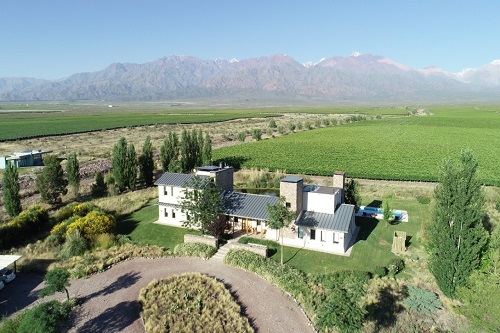The word ‘Argentina’ conjures a flurry of images: gauchos riding the wideopen pampas, delicious steaks, crazy economic cycles and, of course, phenomenal wines. For savvy real estate investors, Argentina should also awaken a sense of deep value and tremendous opportunity. Buy-and-hold (and enjoy) opportunities abound, especially for people who have always dreamed of owning a vineyard estate but find the astronomical price tags in Canada either out of range or hard to justify.
The Argentinian economy, however, is a tough pill for many investors to swallow.
For those unfamiliar with the country’s economic crises, inflation has averaged 144% since World War II and is over 50% in 2019. Over the past decade, GDP growth has been in positive territory four times and negative five times. The currency devalues regularly. The Argentine peso, which was trading at about 6 pesos to one Canadian dollar in 2015, was trading at around 42 pesos to the dollar in August.
Of course, this is bad news for any business tied to Argentina’s local economy. But for a savvy foreign buyer, the timing couldn’t be better. Using Canadian dollars to buy, hold and maintain property in Argentina means your money will go further. For investors who see opportunity, the next factor to consider is what kinds of properties there constitute an exceptional value.
A full glass
For many, the wine-growing regions of the country stand out. To be able to own a vineyard property similar in climate, geography and feel to those in BC’s Okanagan Valley, while investing just a fraction of the cost, is an intensely exciting proposition. As Dan Anderson, a colleague and real estate professional from Kelowna, put it: “The Okanagan Valley has become overpopulated, and the traffic is very congested compared to the countryside of Argentina. The regulations and the red tape are getting harder and harder to get through and have become overbearing.”
While a small vineyard near Kelowna could easily run in the millions, a 64-acre producing vineyard property in the up-andcoming region of San Rafael, Argentina, runs about $145,000. A larger 264-acre ranch is currently listed at $526,000. While San Rafael isn’t as famous as its northern neighbour, Mendoza, for investors looking for deep value and affordable larger properties, this is the region to consider.
For those who want to own an estate in a more refined and established region, Mendoza’s Uco Valley presents the highest value and most sophisticated choices. Mendoza produces the best wines in Argentina and is home to the wineries of Paul Hobbs, Susana Balboa, Bono and the Rothschilds, just to name a few. The soils and climate are exceptional for the production of grapes that yield some of the finest wines on the planet.
Surprisingly, property ownership opportunities in Mendoza remain affordable, especially when compared to similar properties in North America. In California’s famed Napa Valley, vineyard estates start in the low millions and run into the stratosphere. While not quite as high, vineyard homes in the Okanagan are, in comparison to Mendoza, still quite expensive. For real estate investors who can afford these North American properties, Argentina isn’t as exciting. But for many, Mendoza makes it possible to transform the dream of owning a vineyard estate into reality.
An example of the higher end of the price spectrum in the Uco Valley – a property that touches on both vineyard ownership and destination tourism – is the Vines of Mendoza. The five-star property boasts 21 villas for nightly rental, a world-renowned dining establishment and a selection of more than 250 top-ranked Argentinian wines. Vineyard parcels start at $130,000 per acre; nightly room rates start at $1,200.
At the other end of the spectrum are independent stand-alone farms, which provide a unique opportunity to create a personal brand of wine or a new tourist destination B&B (or both). Family farms in and around the Mendoza province range from $450,000 for 26 hectares and a variety of vines in Junin to $725,000 for nine hectares of Malbec vines. Prices are far lower than a managed property, but these options will be far more hands-on. For someone with a passion for wine, however, that might fall into the ‘labour of love’ category.
Just a sip
In between these two extremes are several properties that allow investors to own part of an existing vineyard, enjoying the views and atmosphere of the experience while sidestepping the trials, tribulations and economic risks of being an actual farmer. For example, villas at Casa de Uco, a 325-hectare vineyard with a post-modern flair, start at $750,000. Nightly rates start around $670.
A more traditional Argentinian hacienda feel can be found at establishments such as La Morada’s Gran Vineyard Estates, a 300-hectare mature vineyard that produces more than 3.3 million kilograms of grapes each year, which are used by award-winning wineries to produce their exceptional vintages. Tiny homes and condos in and around the lodge start under $200,000, while estate homes in the vineyard begin under $500,000. Nightly rates start at $200.
Argentina is like the pendulum on an old grandfather clock, swinging back and forth as economic factors change how outsiders perceive the country. But for investors looking for a deep value proposition that can deliver a rich day-to-day experience, the facts merit a good hard look.
 Mike Cobb is CEO of ECI Development, a company that creates value through socially responsible development in communities in Nicaragua, Belize, Costa Rica, Panama and Argentina. For more information, visit ecidevelopment.com.
Mike Cobb is CEO of ECI Development, a company that creates value through socially responsible development in communities in Nicaragua, Belize, Costa Rica, Panama and Argentina. For more information, visit ecidevelopment.com.








